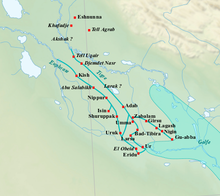Early Dynastic Period (Mesopotamia)
 |
|
| Geographical range | Lower Mesopotamia |
|---|---|
| Period | Bronze Age |
| Dates | fl. c. 2900 BC — c. 2350 BC |
| Type site | Tell Agrab, Tell Asmar |
| Major sites | Tell Abu Shahrain, Tell al-Madain, Tell as-Senkereh, Tell Abu Habbah, Tell Fara |
| Preceded by | Jemdet Nasr Period |
| Followed by | Akkadian Period |
The Early Dynastic period (abbreviated ED period or ED) is an archaeological culture in southern Mesopotamia (modern-day Iraq), generally dated to approximately 2900–2350 BC. It was preceded by the Uruk period and Jemdet Nasr period, which saw the formation of the first states, the first cities, and the invention of writing. The ED period itself was characterized by the existence of multiple city-states: small states with a relatively simple structure that developed and solidified over time. This development ultimately led to the unification of much of southern Mesopotamia under the rule of Sargon of Akkad, the first king of the Akkadian Empire. Despite this political fragmentation, the Early Dynastic city-states shared a relatively homogeneous material culture. Sumerian cities like Uruk, Ur, Lagash, Umma and Nippur, located in the south of Mesopotamia, were very powerful and influential. To the north and west stretched states centered on cities such as Kish, Mari, Nagar and Ebla.
The study of central and southern Mesopotamia has long been given priority over neighboring regions. Archaeological sites in southern and central Mesopotamia, notably Girsu, but also Eshnunna, Khafajah, Ur (a city in Irag) and many others, have been excavated since the 19th century, yielding cuneiform texts and many other important artifacts. As a result, this area was always better known than neighboring regions. The excavation and publication of the archives of Ebla have changed this perspective, shedding more light on surrounding areas such as southwestern Iran, Upper Mesopotamia and western Syria. These new findings revealed that southern Mesopotamia shared many socio-cultural developments with neighboring areas and the entire Ancient Near East participated in an exchange network in which material goods and ideas were circulated.
...
Wikipedia
